Instant messages in Teams happen in channels. Channels are a place where people can type messages, add files, and share links. I like to think of a channel like a virtual water cooler. You go there to communicate with colleagues, learn and share gossip, and generally stay in touch with your social circle.
A channel lives inside of a team, and a team can contain multiple channels. You can name a channel anything you want. I recommend using a name that describes the purpose of the channel. For example, you could name your channels channel01, channel02, channel03, and so on, but these titles aren’t descriptive. Are you creating a channel that people in your team will use to discuss carpooling to and from work? Name the channel Carpooling. Or do you want to create a channel for accounting and another for human resources? Name them Accounting and Human Resources, respectively. Or perhaps a group of people want to discuss the new policy of allowing pets in the office. Create a channel called Pets. You get the point.
A channel can contain multiple conversations happening at the same time. To try to make these threads of conversation easier to follow, Teams groups them together in what are known as threads. A thread is simply a topic of conversation. When someone types a brand-new message, it appears in the channel, and any replies to that original message are placed underneath. If someone else types a different message for a different topic, it will become its own thread and any responses to that message will be grouped under the original message. In the figure, you can see that I am creating a brand-new topic of conversation (“Hello world!”). If I want to reply to the existing topic, I would click the Reply link at the bottom of the thread that starts with “Hello and welcome to the team!”
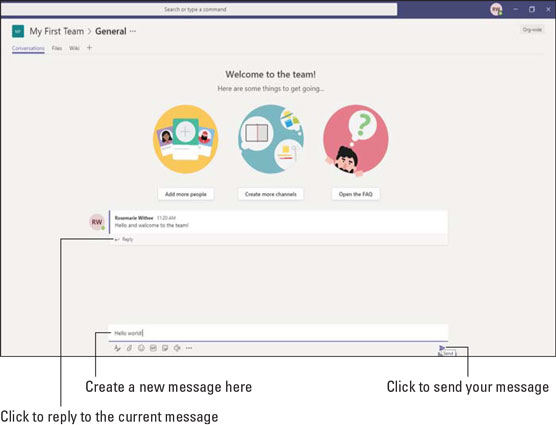 Sending a new message to the General channel.
Sending a new message to the General channel.Replying to an existing topic of conversation (a thread) and creating a new topic of conversation are simply a matter of which Reply link you click and which text box you start typing in. One mistake many people make when first using Teams is to reply in the primary message box for the channel instead of in the reply message box for the thread. It can be confusing at first, but once you notice the two boxes, it quickly becomes second nature.
Sending Messages in Channels
Whenever you create a new team, a channel is created for that team automatically. Called “General,” this channel is perfectly acceptable to use to start chatting with others on the team.To send a message in the General channel, follow these steps:
- Select the Teams icon in the left navigation pane to view all your teams.
Under each team, you will see a list of channels that are available to you. If this is a new team, you will only see the General channel until more channels are created.
In addition to the channels available to you, there may be private channels in the team that you don’t have access to. There could also be channels that are public, but that you have not joined. The list of channels you see under a team might not be inclusive of every channel that team contains.
- Select the General channel, as shown. When you click a channel, it opens in the main part of the screen.
- Type a message in the text box at the bottom of the screen and click the Send icon (or press the Enter key), as shown earlier. Your message appears in the General channel screen.
Notice above your message that Microsoft Teams is giving you some hints about adding more people, creating more channels, and opening the Frequently Asked Questions (FAQ). These buttons that appear in new channels are shortcuts for you. You can achieve these same tasks without using these shortcuts, and you will find out how in the next sections.
 Selecting the General channel that was automatically created when the Team was created.
Selecting the General channel that was automatically created when the Team was created.Creating a New Channel
As you use Teams more and more, you will likely want to create chat channels for other topics so that everything doesn’t happen in one “general” channel. For example, you might want to create a channel for your team to discuss finances, and another for carpooling, and another for team morale events. Team conversations can be organized in seemingly endless ways. The only thing that matters is what works for your team.To create a new channel in your team, follow these steps:
- Select the Teams icon in the left navigation pane to view all your teams.
- Click the ellipsis to the right of the team you wish to add a channel to open the More Options drop-down menu.
- Choose Add channel, as shown.
If this option isn’t shown in the drop-down menu, you don’t have permission to create a new channel. If you are a guest to a team, your ability to create teams and channels can be limited.
 Choosing Add channel from the settings menu for a team.
Choosing Add channel from the settings menu for a team. - Enter a name and description for the channel in the dialog box that appears and then click Add, as shown.
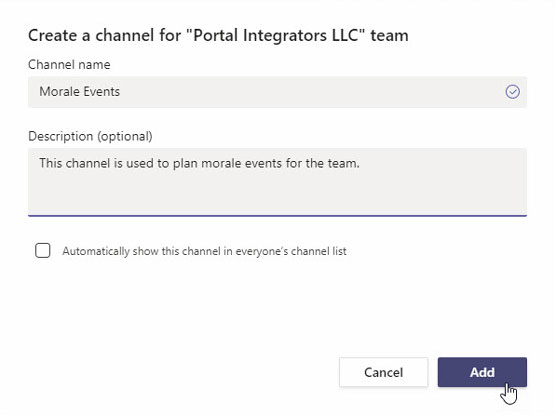 Filling in the dialog box to create a new channel.
Filling in the dialog box to create a new channel.Note that you can also select the box to have this channel automatically show up for every person in the team. If you don’t select this box, the channel will show up as hidden, and people will need to click a button to see it in the list of channels in the team.
The new channel appears under the team as shown.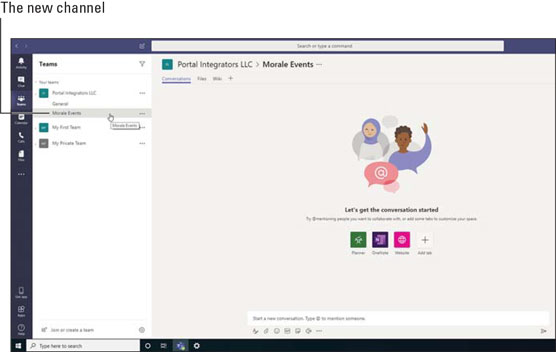 A new channel in a team.
A new channel in a team.You can create chat channels for any topic you want. I have seen teams have a lot of success breaking out core work–related channels from non-core work–related channels, such as morale events in one channel and budget discussions in a different channel.
A channel is part of a team. A team can contain multiple channels, and each channel can contain its own threads of conversation.
Configuring a Channel
You can configure many different settings for a channel via the More Options dialog box. As shown earlier, you access these additional options by clicking the ellipsis next to the channel name you wish to manage. The following figure shows the More Options drop-down menu that appears next to the new channel we created. The options that appear for a channel you add include the following:- Channel notifications: You can configure the notifications you receive for this channel. This is important as your organization’s use of Teams increases. Teams can quickly become noisy with everyone chatting about all manner of topics. You can use this setting to turn down the noise for channels that are less important to you and turn up the volume for topics you need to pay close attention to. The channel notifications dialog box is shown.
 The More Options menu for a team’s channel.
The More Options menu for a team’s channel.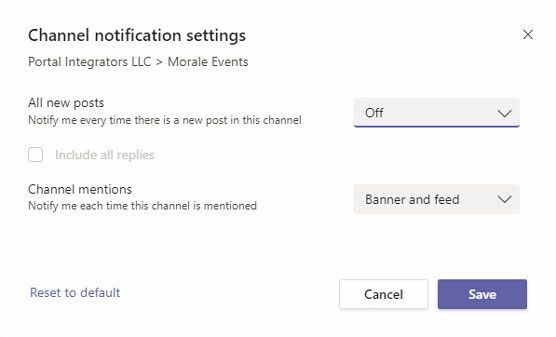 Setting channel notifications.
Setting channel notifications.- Hide: Select this option to hide the channel from the list of channels you have in the team. You can always unhide the channel at any time. You will see a little message that lets you know how many channels you have hidden, and you can click it to see those hidden channels.
- Manage channel: This option allows owners of the channel to manage the permissions for the channel, as shown. You can allow others to moderate the channel and control who can post new messages to the channel.
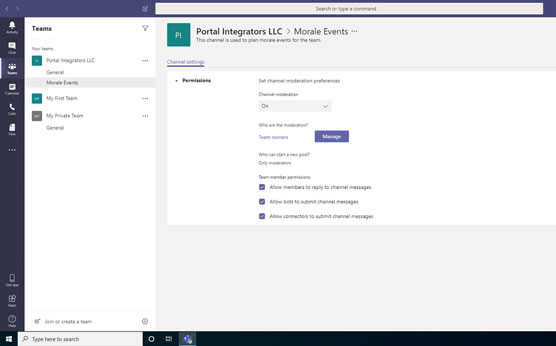 Managing the moderators and permissions for a channel.
Managing the moderators and permissions for a channel.- Get email address: A cool feature I use all the time is the ability to send an email message directly to a channel. You can configure the channel so that if you send an email, the message appears in the channel. (I send a copy of my email messages to my channels all the time!) The following figure shows the email address for the private channel.
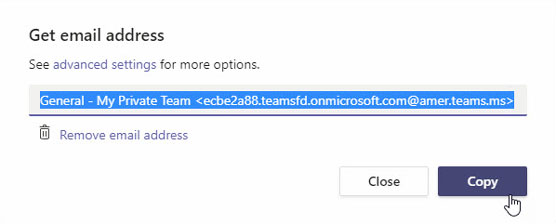 Obtaining the dedicated email address to send email directly to the channel.
Obtaining the dedicated email address to send email directly to the channel.Whenever I send an email message to this address, it appears in the channel, as shown.
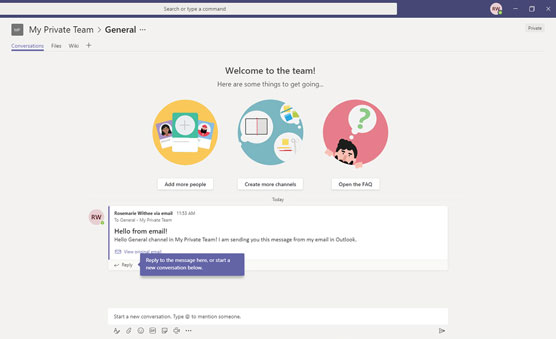 Viewing an email sent to the channel.
Viewing an email sent to the channel.- Get link to channel: You can quickly get overwhelmed with the number of teams and channels in your organization. When you want to tell people about a channel, you can send them a direct link to the channel. You can get the link by using this option.
- Edit this channel: When you first created the channel, you set the title and description. You can change those settings with this option.
- Connectors: Connectors are add-on apps. Think of them as custom extensions to Teams that you can add to a channel in order to connect with other software services. They allow you to connect other apps to your channel. There are many types of connectors, as shown. For example, you can connect your channel to Jira or Twitter or seemingly any other app out on the Internet.
- Delete this channel: When you are ready to remove a channel, you can choose this option to delete it.
 Viewing some of the connectors that are available for a channel.
Viewing some of the connectors that are available for a channel.



